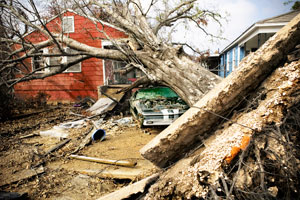Posttraumatic stress disorder (PTSD) now affects one in 29 Americans, reports Kathleen Sebelius, Secretary of the U.S. Department of Health and Human Services, in a June 6 statement. An anxiety disorder, PTSD affects not only combat veterans but also crime and abuse victims, disaster survivors, first responders, and others who have experienced trauma in their lives.
Symptoms of PTSD can include sleep problems, irritability, anger, recurrent dreams about the trauma, intense reactions to reminders of the trauma,  disturbances in relationships, and isolation. The good news is that PTSD is treatable, and new research is helping to identify the kinds of treatment that are most effective.
disturbances in relationships, and isolation. The good news is that PTSD is treatable, and new research is helping to identify the kinds of treatment that are most effective.
“The Department of Health and Human Services, along with the Departments of Veterans Affairs and Defense, are supporting new research to reveal the underlying causes of PTSD and related conditions, develop better tools to identify those at highest risk of developing the disorder, and develop new and better treatments and preventive interventions,” says Sebelius.
The National Institute of Mental Health is also funding research—including both evaluation and intervention studies—on a wide range of PTSD topics. Current NIMH studies are focused on:
- Teens coping with parental military deployment
- The effectiveness of a Web-based intervention for guardians of children whose one parent has murdered the other
- The effects of stress in pregnancy
- Cognitive behavioral treatment for PTSD in people with additional serious mental illnesses
- Comparing behavioral therapies for treating adolescents with PTSD related to sexual abuse
- The development of magnetic resonance imaging techniques for studying mood and anxiety disorders
- Group intervention for interpersonal trauma
- Prazosin for treating noncombat-trauma PTSD
- Psychobiological mechanisms of resilience to trauma
To learn more about these studies, or for information and resources to share with your clients, visit the PTSD Web site at the NIMH.
Filed under: Practice, Research | Tagged: National Institute of Mental Health, nimh, post-traumatic stress disorder, ptsd, PTSD diagnosis | 1 Comment »


 been restored and released by the
been restored and released by the  struggling with poor mental health even today, years after the storm.
struggling with poor mental health even today, years after the storm. care was being administered. The removal of this provision means that military personnel and vets located anywhere in the US may be able to receive counseling through video teleconference technology from a mental health professional located elsewhere.
care was being administered. The removal of this provision means that military personnel and vets located anywhere in the US may be able to receive counseling through video teleconference technology from a mental health professional located elsewhere.